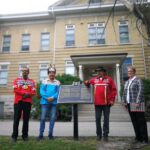A museum that commemorates the history of residential schools from inside one of this province’s only remaining residential school buildings was honoured last week for offering the best Indigenous tourism experiences in Manitoba.
Travel Manitoba handed out its 2023 Manitoba Tourism Awards, which recognize outstanding contributions to the province’s tourism industry, last Thursday at the Canadian Museum for Human Rights (CMHR) in Winnipeg.
The award ceremony included the annual category for best Indigenous Tourism business or operator in Manitoba, and this year’s award was won by the National Indian Residential School Museum of Canada.
The national museum is set up in the building that was formerly the Portage la Prairie Indian Residential School, which operated from around 1915 until 1975.
Unlike most former residential schools that were torn down after closing, the building, which has been designated a national historic site, still stands, and is one of only three former residential school buildings in Manitoba still standing.
Travel Manitoba said in a media release that the museum plays an integral role in conveying the legacy of the residential school era through its displays, and through stories of a “once government-sponsored and church-run residential school system imposed on Indigenous peoples where assimilation efforts focused on destroying their identities, cultures and languages.”
“The purpose is to both create a memorial to those who went through the experience to honour them, and to help many of the survivors with their journey of healing,” Travel Manitoba said.
Lorraine Daniels, the museum’s executive director said one of the main goals of the museum is to give as truthful and accurate an account as possible of what day-to-day life would have been like for Indigenous children who were forced into residential schools, despite the fact that those stories can often be dark and unsettling.
“You need to reveal the truth no matter how hurtful, and ugly, and painful that truth is, because the truth sets us free,” Daniels said in a previous interview. “I want people to learn the truth, and that is why this museum is so important.
“We need people to be educated about the real experiences of the survivors, so we can all heal together.”
The museum features historic artifacts, documents, photographs and displays, all meant to educate those who come through its doors about the history of the residential school system.
One display shows a typical bed a child would have had to sleep on at the school and a mannequin of a young child wearing a typical uniform and haircut that Indigenous children would have been forced to wear in a residential school.
Artifacts from the former school now housed in the museum include school photos, a display of the straps teachers would use to punish children, and a number of pieces of artwork.
The museum also features a room that celebrates traditional Indigenous culture, a culture the residential school system tried for decades to erase.
Travel Manitoba said the museum offers an experience that is “authentic, and promotes or advances Indigenous culture, with goals to educate visitors and generate or stimulate economic activity in the region.”
Anyone looking to get more information about the National Indian Residential School Museum of Canada, or who wants to book a tour can visit their website at nirsmuseum.ca.
An Indian Residential School Crisis Line is available 24-hours-a-day, seven-days-a-week in Canada for anyone experiencing pain or distress as a result of their residential school experience or the experience of someone they know, and can be reached at 1-866-925-4419.
— Dave Baxter is a Local Journalism Initiative reporter who works out of the Winnipeg Sun. The Local Journalism Initiative is funded by the Government of Canada.







